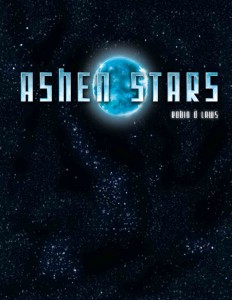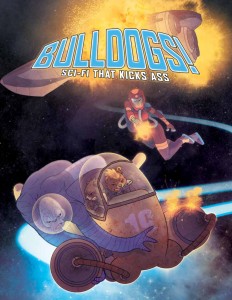Previously, I’ve talked a bit about our short campaign of Ashen Stars. In this post, I’ll be diving into a few more details about the game book, though it won’t be my own musings entirely.
This autumn, I started recording a podcast about roleplaying games with three other Danish roleplayers – Morten Greis, Oliver Nøglebæk and Nis Baggesen. The podcast is called Lænestolsrollspil, which is Danish for Arm Chair Roleplaying – because we are sitting around a mike talking about a roleplaying book that we’ve read, but not necessarily played (though in practice, we choose books we have an interest in, which usually means at least one of us has played it).
We launched three weeks ago, and our first episode was on Ashen Stars. I’ve been debating what to do with it since. I want to write about our podcast here. Now, I have reason to believe that a great many of my readers are Danes. For that reason, I don’t want to just rehash everything we say in the podcast – I’d rather you go here and listen to the podcast.
I made this blog in English, though, so that it would also be accessible to foreigners, and so I’d like to give a taste of what we talk about in the podcast.
And so, below I’ll try to give a brief overview of Ashen Stars, including some of the main points from the podcast.
What is Ashen Stars?
Ashen Stars is a space opera investigation game by Robin D. Laws. To put it crudely, take a world a bit like Star Trek or Babylon 5, add in a crew and a ship like in Firefly, but turn them into investigators, and make it a police procedural instead of a Western.
The rules, meanwhile, are an iteration of the GUMSHOE system of rules. GUMSHOE was developed by Laws as a way to make investigation without the risk of stalling due to poor dice rolling. In character creation, you divvy up all the different investigative skills, so that all of them are represented in the crew. If you have a skill, you get the associated clue, but you can sometimes spend a point from that skill to gain a benefit.
The other skills, including the more action-oriented ones involved in fighting and flying a spacecraft, have a separate budget of points. When you roll one of these, the GM chooses a difficulty (without telling you), then you select a number of points to spend from your skill and add a d6 to that. If you roll equal to or higher than the difficulty, you succeed.
To that is added a system of story generation. Each character has a Drive, which is something that makes them want to go out into space. To this is added an “arc”, that is, a personal story the player wants their character to live through.
Skills: An economy of abundance
A lot of the game is tied up in the point spending economy. Unfortunately, that part doesn’t seem as smooth as we would have liked. When we played it, we never had to think about spending points from our investigative abilities. Can I spend? Sure, I will. I have so many abilities, and so many points, it’s not that likely I’ll run out of spends, unless the GM really wants me to. Then he’ll focus on one or two of my abilities, but that would be a somewhat dickish move.
I’m also not a fan of the way all the investigative skills get partitioned out among the players. It means we can get all clues merely by having the right guy show up on the scene. I think I would prefer having us decide which skills we feel fit our characters. If we’re missing some skills – well, then we’d better get creative and learn to do without.
One final comment on the skills: I find them a bit difficult to get a grip on. I think this is where the space opera setting interferes with the investigation. What, for instance, can you do with an “Energy Signatures” skill? Or how about “Industrial Design”? These skills make perfect sense in the setting, but they are difficult for me as a player or GM to understand intuitively.
Stories: Planets and cases and arcs, oh my
The book gives some pretty good advice on telling stories. Introducing story arcs work well to distribute spotlight. Meanwhile, the chapter on creating worlds for cases is pretty good, helping the GM create very distinctive planets for their cases. It would have been nice to have some advice for GMs on turning their cases into a cohesive whole – an “arc” for the whole campaign, and maybe mechanics or guidelines for tying up a season, changing arcs and Drives, and changing direction of the campaign.
While the book does pretty well on the big picture stuff, it seems there is very little advise on how to actually run the game. It tells you how to make core clues, but how do you use them in play?
Setting: the gritty reboot
The setting of the game is a rehash of other space opera shows, with a few peculiarities of its own thrown in. It frames itself as the gritty reboot of a hopeful sci-fi show, set after the near-collapse of the great galactic Fede… Combine.
Mostly it works well, but in the podcast, we object to a few things. One major thing is the major gimmick of the game: there was a big war, but nobody remembers it. Why? Nobody knows, and it’s difficult to even think about it. Ah, so this much be a central part of the game? Nah, not really. It seems to be primarily a way to have it not be about the war. But it seems weird, and not all that elegant. You’re putting a huge plot right in front of the players, but then telling them: “But that’s not what our story is going to be about.” Why not? Why not just say that the Mohilar were defeated, or retreated, or something? The amnesia is such a huge thing, it’s almost impossible to get around.
…but do you like it?
To conclude, I’ll say what I said in the podcast: I like the idea of Ashen Stars much more than I like the actual rules. The races seem interesting, the universe is mostly good, and being crews of freelance investigators is a great way of framing an investigative adventuring party. But the implementation is often inelegant, and frustrating, because it doesn’t really help me do the investigative stories I would like to do. It’s a pity, but that sees to be the long and the short of it.
The next episode of the podcast is already up. In it, we look at something completely different: In a Wicked Age by D. Vincent Baker.

